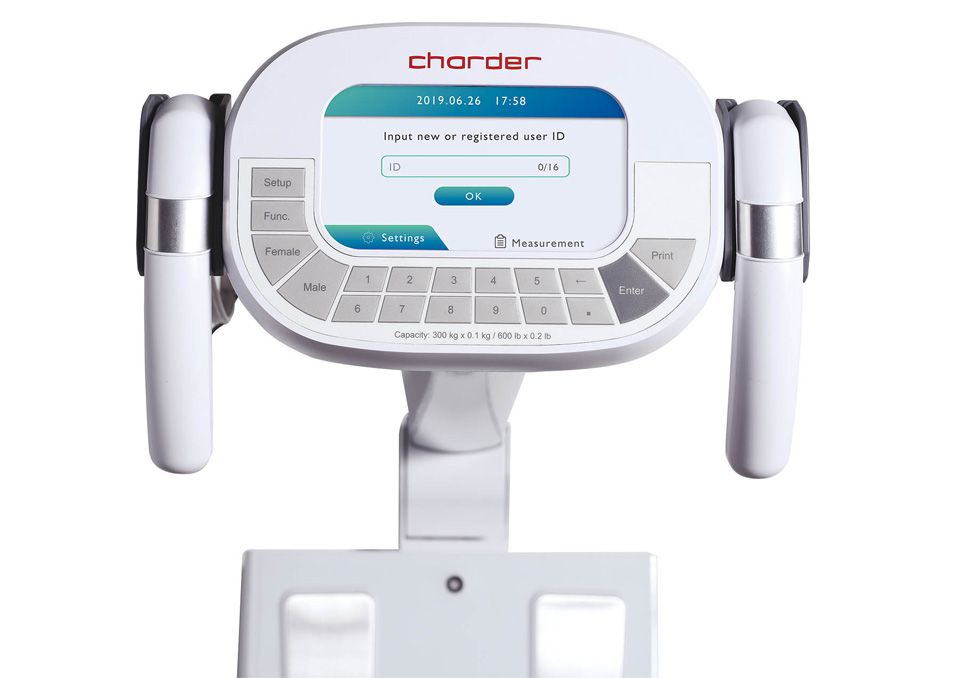Easy to use
With an intuitive touchscreen interface and voice guidance during the measurement process, minimal training is required to operate Charder's professional instruments safely and correctly. Perform a specific test in less than a minute and get clinically validated results.
Non-invasive and safe bioelectrical impedance analysis
With Bioelectrical Impedance Analysis (BIA), our devices send a safe, alternating current through the body via the machine's touch points. Through advanced algorithms that analyze resistance to electrical current, we provide muscle, fat, water, cell health, metabolic and more performance!
Clinically validated results
It's not just how many results you get, it's whether you can trust them. Charder's years of research in bioelectrical impedance analysis includes the use of artificial neural networks, with algorithms that have been developed and validated against gold-standards such as computed tomography and dual X-ray absorptiometry for reproducible results.

What is body composition?
Simply put, body composition analysers analyse the body and divide it into its basic components of water, fat, protein and minerals. This provides a detailed and accurate weight breakdown and provides key insights that traditional methods such as BMI cannot.
Why is BMI not enough for professional use?
The Body Mass Index (BMI) is a commonly used method of assessing the health of an individual by comparing their weight and health status. The primary limitation of BMI is that it only uses total body weight and there is no way to determine whether weight changes are due to fat or muscle. Two people with the same BMI should be classified as having the same health risk, even if one is mostly fat and the other is mostly muscle!
Why is body composition measurement important?
Traditionally, many fitness or dietary goals have focused on weight gain or loss - understandable if you only have one scale. With bioelectrical impedance analysis (BIA), which makes body composition more accessible, safe and affordable than other analysis methods, you can regularly monitor key components of your body, giving you a valuable snapshot of your health!

What does our resistance show?
Generally speaking, water acts as a conductor, so more body water correlates with decreased Resistance. According to this principle, because muscle contains a significant amount of water, people with increased muscle mass will have lower resistance. In contrast, because fat acts as an insulator, more fat correlates with increased resistance
What does resistance show?
When an electric current passes through the body's cells, cell membranes can store charge and act as capacitors, creating capacitive resistance. Thus reactance is used to determine the energy storage capacity of a cell, indirectly reflecting the integrity and strength of the cell.
Using clinically validated algorithms, BIA Body Composition Analysers tools can calculate fat, muscle, body water and other parameters using Impedance, Reactance, Resistance and other variables such as height, gender, age and weight. The applicability of a BIA tool depends essentially on the mathematical equations and algorithms used to calculate body composition. The development and validation of these equations is a technically complex process and the validity of the equations ultimately determines the accuracy of the BIA tool

(1) Body Composition Analysis
Reliable, non-invasive bioelectrical impedance analysis facilitates the systematic monitoring of body composition. The calculated estimated weight of body composition elements can be compared with standard results - for context.
(2) Muscle-fat analysis
The measurement of body weight is important but incomplete without further analysis of the patient's muscle and fat mass. An understanding of skeletal muscle and body fat ratios can help coaches formulate muscle and fat control recommendations.
(3) Obesity analysis
MA601 categorizes body fat ranges into categories commonly observed in underweight, athletic, normal, overweight, and obese populations. With more precise ranges, fat control goals and progress can be tracked more accurately. Visceral fat levels are related to abdominal visceral fat area and are used as an indicator of obesity-related disease risk.

(4) Segmental analysis
Segmental analysis of the trunk, upper body and lower body allows you to measure muscle and fat more accurately. Identify imbalances and determine if segmental muscle is within the normal range, track changes to better monitor the effects of rehabilitation or exercise.
(5) Body type analysis
The body type analysis table combines BMI and body fat percentage to determine the subject's body type. The body composition changes required to achieve an ideal body type can be clearly determined using this clear and simple table.
(6) Muscle quality
Track changes in quality, not just quantity! In older people, muscle strength can decline much faster than muscle mass. By assessing muscle efficiency through a cellular estimate of grip strength health, professionals now have a more useful indicator that can provide an early warning of fall risk.
Bioelectrical Impedance Analysis in a Mathematical Model for Estimating Fat-free Mass in Multiple Segments in Elderly Taiwanese Males
(7) Body composition history
By selecting the same user ID before the measurement, changes in body composition (body weight, fat-free mass, skeletal muscle mass and body fat percentage) can be automatically tracked.
(8) Fitness parameters
MA601 provides several body composition output parameters of particular relevance to fitness and includes various indices used as early warning signs of malnutrition and sarcopenia. Take advantage of the Phase Angle measurement to assess cellular health and analyse health status in more detail.
(9) Health score
The scorecard provides normal ranges for different outcomes, as well as an overall health score that takes into account a combination of outcomes.
(10) Control Guide
The Control Guide calculates the recommended amount of muscle and fat control to achieve an ideal, healthy body type. This can be used as a general reference for a "standard" body type, although subjects can of course choose to use their own goals and calculations instead.
